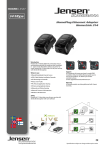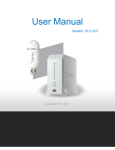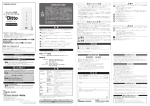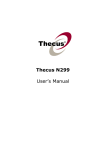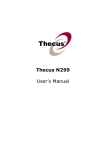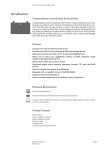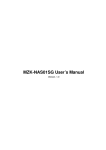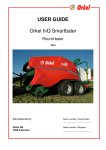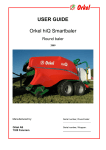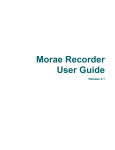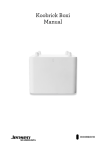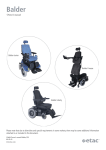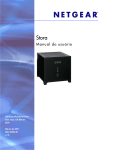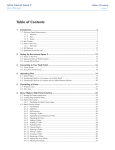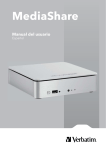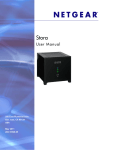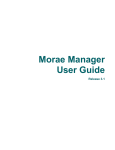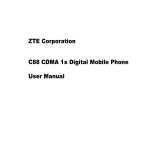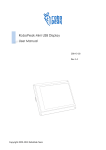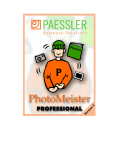Download myDitto User Manual - Jensen of Scandinavia
Transcript
User Manual eBOX User Manual 2 1 Table of Contents 2 OVERVIEW 6 2.1 2.2 2.3 2.4 2.5 INTRODUCTION SPECIFICATIONS ENVIRONMENTAL SPECIFICATIONS PRODUCT USE REQUIREMENTS PRODUCT COMPATIBILITY 6 6 7 7 7 3 GETTING ACQUAINTED WITH eBOX 8 3.1 3.2 3.2.1 3.2.2 PACKAGE CONTENTS PRODUCT VIEW FRONT VIEW BACK VIEW 8 9 9 10 4 GETTING STARTED 11 4.1 4.2 4.3 4.4 4.4.1 4.4.2 4.4.3 INSTALLING eBOX TO TURN eBOX eBOX KEYS ACCESSING eBOX USING THE eBOX KEY ACCESS FROM A MOBILE HANDHELD DEVICE ACCESS DIRECTLY FROM THE LOCAL AREA NETWORK 11 11 12 13 13 15 17 5 eBOX APPLICATION 20 5.1 5.2 5.2.1 5.2.2 5.2.3 5.2.4 5.3 5.3.1 5.3.2 5.4 5.4.1 5.4.2 5.4.3 INTRODUCTION eBOX APPLICATION - MAIN PAGE TOP MENU BAR MY FILES / SEARCH BAR REMOTE / LOCAL VIEWS STATUS BAR eBOX APPLICATION – MANAGING FILES & FOLDERS OVERVIEW FUNCTIONS eBOX APPLICATION – AUTOMATED FILE BACKUP BACKUP SERVICE INSTALLATION HOW DO I CHOOSE FILES/FOLDERS FOR BACKUP? HOW DO I REMOVE FILES/FOLDERS FROM BACKUP? 20 20 21 21 22 23 23 23 24 25 25 26 27 JensenScandinavia AS All rights reserved 2011 eBOX User Manual 3 5.4.4 BACKUP INDICATION 5.4.5 BACKUP TAB 5.4.6 HOW TO UNINSTALL THE BACKUP PROCESS*? 5.5 eBOX APPLICATION – MUSIC STREAMING 5.5.1 HOW? 5.5.2 eBOX APPLICATION – PLAY LIST 5.5.3 HOW TO DELETE A PLAYLIST? 5.6 eBOX APPLICATION – SEARCH 5.7 eBOX APPLICATION – FILE TRANSFER VIEW 5.8 eBOX APPLICATION – DESKTOP CLIENT 5.8.1 HOW TO INSTALL? 5.8.2 HOW TO UNINSTALL? 5.9 eBOX APPLICATION – SHARING 5.9.1 HOW? 5.9.2 WHAT ELSE? 5.10 eBOX APPLICATION – SAVE TO REMOTE 5.10.1 HOW? 5.11 eBOX APPLICATION – DISCONNECT IDLE CLIENT 5.11.1 HOW? 5.12 eBOX APPLICATION – SETTINGS 5.13 eBOX APPLICATION – ADVANCED SETTINGS 5.13.1 ADVANCED SETTINGS – GENERAL 5.13.2 ADVANCED SETTINGS – DATE & TIME 5.13.3 ADVANCED SETTINGS – NETWORK 5.13.4 ADVANCED SETTINGS – PRINT SERVER 5.13.5 ADVANCED SETTINGS – BITTORRENT 5.13.6 ADVANCED SETTINGS – ITUNES SERVER 5.13.7 ADVANCED SETTINGS – MEDIA SERVER 5.13.8 ADVANCED SETTINGS – TOOLS 5.13.9 RESET 5.14 eBOX APPLICATION –MOBILE APPLICATION 5.14.1 MAIN VIEW 5.14.2 WHAT CAN I DO WITH THE MOBILE APPLICATION? 5.15 eBOX APPLICATION - HELP 27 28 29 30 30 30 32 32 33 33 33 34 34 34 35 37 37 37 37 38 44 45 45 46 47 48 50 50 51 56 57 57 57 57 6 MOBILE APPLICATION 58 6.1 6.2 6.2.1 6.2.2 6.2.3 6.2.4 6.3 INSTALLATION IOS (IPHONE/IPOD TOUCH/IPAD) HOW TO CONNECT HOW TO BROWSE A FOLDER OR OPEN A FILE HOW TO UPLOAD PHOTOS HOW TO STREAM MUSIC ANDROID 58 58 58 59 59 60 61 JensenScandinavia AS All rights reserved 2011 eBOX User Manual 4 6.3.1 HOW TO CONNECT 6.3.2 HOW TO BROWSE A FOLDER OR OPEN A FILE 6.3.3 HOW TO STREAM MUSIC 61 61 62 7 MANAGING eBOX KEYS 63 7.1 7.2 7.2.1 7.2.2 7.3 7.3.1 7.3.2 7.4 7.5 7.6 OVERVIEW ADDING ADDITIONAL eBOX USERS REGISTERING NEW eBOX KEYS: START USING A NEW MOBILE PHONE CHANGING PASSWORDS SOLUTION A – KEY AUTHENTICATION SOLUTION B – REMOTE PASSWORD CHANGE CHANGING THE ADMINISTRATOR (MASTER KEY HOLDER) PASSWORD* LOST STANDARD KEYS LOST MASTER KEY 63 63 63 64 64 64 64 65 65 66 8 SYSTEM UPDATES 67 8.1 8.2 8.2.1 8.2.2 eBOX UPDATE (ADMINISTRATOR ONLY) eBOX UPDATES MANDATORY UPDATE OPTIONAL UPDATE 67 67 67 67 9 MANAGING eBOX INTERNAL DISKS 69 9.1 9.2 9.3 9.4 9.5 9.6 9.7 OVERVIEW eBOX NO INTERNAL DISK eBOX WITH ONE INTERNAL DISK – NOT READY FOR USE eBOX WITH TWO INTERNAL DISKS, ONE OF WHICH IS NOT READY FOR USE eBOX WITH TWO INTERNAL DISKS, BOTH ARE NOT READY FOR USE RAID ERROR CHANGING THE RAID MODE 69 69 70 72 75 78 80 10 MANAGING EXTERNAL USB STORAGE DEVICES 81 10.1 OVERVIEW 10.2 SINGLE-TOUCH COPY 10.3 CONNECT EXTERNAL HARD DRIVE 10.3.1 TO DISCONNECT THE EXTERNAL HARD DRIVE: 81 81 82 83 11 84 eBOX AS A MULTIMEDIA HUB JensenScandinavia AS All rights reserved 2011 eBOX User Manual 5 11.1 XBOX 360 / PLAY STATION 3 11.2 DIGITAL PICTURE FRAMES 11.3 ITUNES 11.4 NETWORK MUSIC PLAYER AND DIGITAL MEDIA ADAPTERS 11.4.1 COMPLIES WITH MEDIA STANDARDS 84 84 85 85 85 12 86 INSTALLING HARD DISK DRIVES 12.1 HARD DISK DRIVE INSTALLATION 86 13 88 TROUBLESHOOTING 13.1 GENERAL 13.2 CLIENT MESSAGE – ON PCS 13.3 CLIENT MESSAGE – ON MOBILE DEVICES 13.4 LED TROUBLESHOOTING 13.5 BACKUP 13.6 RESTORE TO FACTORY SETTINGS 13.6.1 HOW? 88 88 90 92 95 97 98 14 F.A.Q. 99 14.1 14.2 14.3 14.4 14.5 14.6 HOW TO REGISTER A NEW USER ON eBOX HOW TO RESET THE ADMINISTRATOR ACCOUNT? I LOST MY PASSWORD, WHAT SHOULD I DO? WHAT HAPPENED IF I LOST eBOX USB KEY? HOW TO RESET THE SERVER SETTINGS? WHICH HARD DRIVES ARE COMPATIBLE WITH THE eBOX? 99 99 99 100 100 100 15 APPENDIX 101 15.1 HOW TO CONFIGURE THE PRINTER ON A COMPUTER 15.1.1 WIN 7: 15.1.2 MAC 10.5.X OS: 15.1.3 UBUNTU 10.4 LTS: JensenScandinavia AS All rights reserved 2011 101 101 103 105 eBOX User Manual 6 2 Overview 2.1 Introduction Congratulations on your eBOX purchase. eBOX is an innovative and powerful, yet easy touse home and office network storage server. It gives you total freedom to securely access your digital files — anytime, anywhere. Technology at a Glance eBOX employs an advanced networking technology that frees users from needing any technical knowledge to operate the device. By leveraging technology used in enterprise and security applications, the developers of eBOX have implemented various approaches to overcome the NAT (Network Address Translation) traversal problem that prevents a user from connecting to their computer from outside their network. Both powerful and reliable, the inner algorithm facilitates peer-topeer communication, compression and natural encryption. Using effective data transmission also enables the smooth streaming of audio and video to your mobile devices. 2.2 Specifications Maximum Storage Capacity 2 x 2TB (Accessible capacity may be less) Transfer Rate 10/100/1000 Mbps Protocols in Use Samba (SMB); eBOX proprietary Supported USB File Systems NTFS, FAT, EXT Interfaces Ethernet (RJ-45) port 2 x USB 2.0 ports Hard Drives 3.5” SATA 1 and 2 RAID 0 and 1, JBOD Networking Protocols Samba (SMB); eBOX proprietary Multimedia Protocols Complies with UPnP, DLNA 1.5, iTunes® Physical Dimensions Width: 3.31” 77mm Depth: 6.49” 165mm Length: 7.48” 190mm JensenScandinavia AS All rights reserved 2011 eBOX User Manual 7 Weight: 2.62lbs 1.19 Kg (not including hard disks) Power DC 12V, 4A 2.3 Environmental Specifications Operating Temperature 0°~40° C / 32°~104° F Humidity 10% - 90% (non-condensing) 2.4 Product Use Requirements Ethernet router (or Internet box) with at least one available port Broadband internet connection (for remote access use) 2.5 Product Compatibility Computer Operating Systems: Windows® 7, Windows Vista® TM, Windows® XP Macintosh® OS X 10.6 or higher (Intel architecture) Linux®, Ubuntu® 10.4 LTS Mobile Handheld Operating Systems: Windows Mobile® 6 or higher. iPad®/iPhone®/iPod Touch® iOS 3.1 or higher Android® 2.1 and higher JensenScandinavia AS All rights reserved 2011 eBOX User Manual 8 3 Getting acquainted with eBOX 3.1 Package Contents 2 eBOX keys eBOX Ethernet cable Detachable (1 master/administrator key pads) (gray) & 1 standard/user key (white))* stand (plastic External power supply Quick User Guide * While both eBOX keys function in the same way, the master key has additional administrator privileges. Additional eBOX keys can be purchased separately from retail outlets that carry eBOX (pack of 3 standard keys and 1 master key or pack of 2 standard keys, please check the section “where to buy” on www.JensenScandinavia.com). Find more information about eBOX keys in section 6, Mobile application Installation Please refer to 4.4.2 Access from a Mobile Handheld Device page 15. JensenScandinavia AS All rights reserved 2011 eBOX User Manual 3.2 iOS (iPhone/iPod Touch/iPad) 3.2.1 How to Connect 1. Launch the application 2. At the connection screen, input your eBOX’s email address and password. 3. Then you can see the files on your eBOX. JensenScandinavia AS All rights reserved 2011 9 eBOX User Manual 3.2.2 How to browse a folder or open a file 1. Just click on a folder in order to go inside it or on a file to download and open it. 2. The downloaded file will be opened in the 3rd tab. 3.2.3 How to upload photos 1. Click on the camera icon (top right) JensenScandinavia AS All rights reserved 2011 10 eBOX User Manual 11 2. Select the photo which you want to upload from your album and it will automatically upload it. 3.2.4 How to stream music 1. Browse to a music directory 2. Click on a MP3 file and it will automatically be streamed JensenScandinavia AS All rights reserved 2011 eBOX User Manual 3.3 Android 3.3.1 How to Connect 1. Launch the application 2. At the connection screen, input your eBOX’s email address and password. 3. Then you can see the files on your eBOX. 3.3.2 How to browse a folder or open a file 1. Just click on a folder in order to go inside it or on a file to download and open it. 2. The downloaded file will be opened in the 3rd tab. JensenScandinavia AS All rights reserved 2011 12 eBOX User Manual 13 3.3.3 How to stream music 1. Browse to a music directory 2. Click on a MP3 file and it will automatically be streamed Managing eBOX Keys, on page 58. 3.4 Product View 3.4.1 Front view LED Indicators 1. Power 2. LAN 3. Status 4. USB1 5. USB2 6. Hard Disk1 7. Hard Disk2 8. Release (button) eBOX shut down* JensenScandinavia AS All rights reserved 2011 eBOX User Manual 9. Copy (button) 14 (1) Key authentication (2) Copy content of external USB device 8+9. Release (button) and Copy (button) 10. USB_1 (port) Deactivate master key** For eBOX key authentication * Pressing the release button until the first beep shuts down the eBOX. Then eBOX can be safely switched off. ** Pressing the release and copy buttons until hearing the first beep deactivates the master key without erasing anything from the hard disk drive (in the event of a lost master key). For more information, refer to section 7.6, Lost Master Key, on page 66. 3.4.2 Back View 11. Power switch Turns eBOX On/Off 12. USB_2 (port) To be used with external USB storage devices: 1. For single-touch copy, see section 10.2 Single-touch Copy on page 81. 2. Connecting an external USB drive, see section 10.3 Connect External Hard Drive on page 82. 13. Hard Disk Drawers House the hard disk drives* 14. Power Supply Connects eBOX to its power adaptor and the power source JensenScandinavia AS All rights reserved 2011 eBOX User Manual 15. Ethernet Port 15 Connects eBOX to a local network (router or ISP box) * For information on how to replace or add a hard disk drive, see section 12, Installing Hard Disk Drives, on page 86. JensenScandinavia AS All rights reserved 2011 eBOX User Manual 16 4 Getting started 4.1 Installing eBOX 1. Connect the Ethernet cable from eBOX to your router (or ISP box) 2. Connect to the Power Supply 3. Switch the Power Button to On Note: Before you start, make sure your router is working and connected to the Internet. Powering up should take approx. 2 minutes. Once completed, the LED indicators will become illuminated, as shown in the above image. 4.2 To Turn eBOX Off Press the RELEASE button until a beep is heard. All LED indicators will turn off, with the exception of the LAN LED. Now wait an additional 10 seconds and then switch the power button to off on the back of the device. JensenScandinavia AS All rights reserved 2011 eBOX User Manual 17 4.3 eBOX Keys eBOX keys enable users to remotely access their network server’s files with an easy-to-use USB key. With your eBOX key, you will be able to safely access any file from eBOX — no matter where you are. There are 2 types of eBOX key holders: Standard eBOX key holders or users – up to 10 of them.* Master eBOX key holder or user – one only, as this key contains Administrator privileges. * For adding new eBOX users refer to section 7.2, Adding Additional eBOX Users, on page 63. Users with a standard eBOX key have the ability to: Access their own private folder, shared folder and any public folder. Change their own username and password. A master eBOX key contains these additional administrator privileges: VIEW all users and their status (without accessing their private and shared folders). DELETE users and the contents of their private folders. DEACTIVATE users; block a user’s key access to eBOX. EDIT user's passwords. EDIT usernames. Set the system clock: date & time. Format hard disk drives. Change the eBOX and workgroup names. Disable/enable media server and iTunes services. For more details on how to use the administrator functions refer to section 5.12, eBOX Application – Settings, on page 38. JensenScandinavia AS All rights reserved 2011 eBOX User Manual 18 4.4 Accessing eBOX 4.4.1 Using the eBOX Key You can access your files from anywhere with your eBOX key. The steps below will show you how to use your eBOX key and remotely access your files whenever you need them. Step 1: Plug in the master USB key (gray) and wait a few seconds until your computer has identified the eBOX key. Step 2: 1. Launch the eBOX application: a. Windows OS – click on eBOX.exe (using Windows XP, just click on the eBOX icon in the autorun box) b. Mac OS – click on eBOX.app c. Linux OS – click on eBOX.sh 2. A splash screen will appear for several seconds until the application is up. 3. When a connection has been established, the bottom left “disconnected/connecting” icon will switch to green. Step 3: 1. Enter your username:* a. 1-31 characters: b. Letters, digits, underscore (_) and hyphen (-) c. No spaces d. Case insensitive e. Letters with accents, for example: é, è, ë, ï are not allowed 2. Enter your password: a. 1-20 characters JensenScandinavia AS All rights reserved 2011 eBOX User Manual 19 b. Letters, digits and the following symbols: !, @, #, $, %, ^, &, *, (, ) c. No spaces d. Case sensitive 3. Enter your Email address (optional):** a. Valid Email address * Usernames are stored and remembered for future use **Email address is used in order to activate your mobile application Once you have completed this simple authentication process, a private folder will be created in eBOX bearing the username. Note: Changing usernames and passwords can be done from the menu settings in the eBOX application. Step 4: The right-side view shows your computer’s directories, while the left side view shows the eBOX. Now you can store, backup and access your data by dragging & dropping files or folders from anywhere in your computer to eBOX, and vice versa. JensenScandinavia AS All rights reserved 2011 eBOX User Manual 20 Note: In order to access a computer remotely, it must either be connected to the Internet or to the same local network as eBOX. 4.4.2 Access from a Mobile Handheld Device eBOX is also accessible from a large variety of mobile devices. In order to enjoy direct, peerto-peer access to eBOX from your mobile device, the eBOX mobile application must be installed and your Email must be verified. Verify Email address: If a valid Email address been entered at first registration: 1. An automatic approval message will be send to the email address. 2. After confirming the message you are ready to access the mobile application. Otherwise: 1. 2. 3. 4. Press on the top right phone icon. Enter a valid Email address and click send. An automatic approval message will be sent to the email address. After confirming the message you are ready to access to the mobile application. JensenScandinavia AS All rights reserved 2011 eBOX User Manual 21 Then, in order to register your mobile phone, you have to install the eBOX mobile application: For iPad/iPhone/iPod Touch: 1. 2. 3. 4. Go to the iPhone App Store. Search for the my-Ditto application. Install it and launch the application. Enter your Email address and click ok. For Android: 1. 2. 3. 4. Go to the Android Market. Search for the my-Ditto application. Install it and launch the application. Enter your Email address and click ok. Windows Mobile OS 6.1 or Higher: 1. Go to the my-Ditto web site support page located at www.my-Ditto.com and select the my-Ditto application for Windows Mobile. 2. Download the “.cab” file 3. Copy the file to the mobile 4. Launch “.cab” directly from the mobile (using the file explorer) 5. Launch the my-Ditto mobile application. 6. Enter your Email address and click ok. Note: The mobile application version and the eBOX version must be the same. Then before downloading the new mobile application, make sure your eBOX is up to date. For more information, refer to section 8 System updates, on page 67. JensenScandinavia AS All rights reserved 2011 eBOX User Manual 22 4.4.3 Access Directly from the Local Area Network This is an alternative way to access the eBOX once it has been connected to the network router. Any computer or device connected to your home or office network will now recognize eBOX as an additional network or workgroup computer. At this stage, eBOX will contain a single folder named Public. If you are using both hard disk drives, each one will receive its own Public folder. As users register, additional private (password-protected) folders will be added and can be identified by their username. Shared folders created by users will also be displayed using their alias. Only allowed users will be able to access them. How? There are two ways to access directly eBOX folders within the local network: 1. Use the access button located at network/backup tab at the settings. Refer to 5.12 eBOX Application – Settings page 38 for more details, or 2. find eBOX on the different operating systems: Windows: XP : My Computer My Network Places View workgroup computers Vista : Control Panel Network Center 7 : Computer Network JensenScandinavia AS All rights reserved 2011 eBOX User Manual Note: Windows usually saves the last user’s login information, and as a result may not allow new users to login to their private folders (from the same computer) without changing settings first. To change settings, go to Tools Disconnect Network Drive select \\the eBOX server name (default is eBOX); press return and click ok. Now Windows will accept a new password. Note: You can also gain access to the eBOX server from: Start Run type: \\the eBOX server name (default is eBOX); press return. Mac: Go Computer SHARED Note: Mac OS X usually saves the last user’s login information and as a result, may not allow new users to login without changing settings first. In order to login as a different user, select the eBOX computer, and click on: Connect as Enter your username and password and click Connect. JensenScandinavia AS All rights reserved 2011 23 eBOX User Manual Note: Another solution is to use the Finder. In menu bar click on “Connect to a server.” Then input the eBOX server’s name (default eBOX) IE: smb://ebox Connect as Enter your username and password and click Connect. Linux Ubuntu/Fedora/Redhat: Go to Places Network JensenScandinavia AS All rights reserved 2011 24 eBOX User Manual 25 5 eBOX Application 5.1 Introduction The eBOX application is stored on every eBOX key. It has been specifically designed with a very simple and intuitive interface for managing and accessing your digital files, within your network or outside of it. A similar version of this application can be downloaded and installed on mobile phones, giving you the freedom to access the eBOX from anywhere in the world. 5.2 eBOX Application - Main Page The application’s main page is divided into two displays: Remote (left side), which shows eBOX files and folders. Local (right side), which shows your local computer. Most of the file interaction happens between these two panels. JensenScandinavia AS All rights reserved 2011 eBOX User Manual 26 5.2.1 Top Menu Bar 1 2 3 4 5 6 1. eBOX name – the default given name is “eBOX.” 2. Installing Desktop Client (available only at local network) - Refer to 5.8, eBOX Application – Desktop Client, on page 33 for more details. 3. Email Address for Mobile Access – enables mobile phone access to the eBOX. Refer to 4.4.2, “Access from a Mobile Handheld Device,” on page 15 for more details. 4. Settings – opens the application settings window. Refer to section 5.12, eBOX Application – Settings, on page 38, for more information. 5. Help – opens the eBOX User Manual. 6. Application Window Buttons - Minimize, Maximize, and Close (before removing the eBOX key from the computer, close the application by clicking the ‘x’ button). 5.2.2 My Files / Search Bar 1 2 3 4 5 6 7 1. Search Bar – where search queries are entered; i.e. files names to be searched for. 2. Search Button – executes the search request. Pressing the return key will do the same. 3. My Files – current view showing eBOX files and folders on the main page. 4. Search Results – displays all file occurrences under a given username. 5. Play List – display songs that been recently played. Enables the user to play multiple songs in a row. Refer to section Feil! Fant ikke referansekilden., Feil! Fant ikke referansekilden., on page Feil! Bokmerke er ikke definert. for more details. 6. Backup status - reports the status of the backup. Refer to chapter 5, section 5.4 eBOX Application – Automated File Backup on Page 24 for more details. 7. Transferring status - Shows the transfer rate and the jobs queue (appears when there are items to transfer). JensenScandinavia AS All rights reserved 2011 eBOX User Manual 27 5.2.3 Remote / Local Views Header 2 1 3 1. Remote View – eBOX’s content 2. Username – username of the connected user (you) 3. Local View – local computer content Files View 1 1 2 4 2 3 4 5 1. Navigation Commands – Back, Forward, Parent folder, Refresh folder. 2. View Change- shows all viewing options: a. Details b. Icons c. List d. Thumbnail 3. Backup Icon – Add or remove files and folders from backup. Refer to section 5.4 eBOX Application – Automated File Backup on page 25 for more details. 4. Folder Path – shows the full path of a displayed folder. JensenScandinavia AS All rights reserved 2011 eBOX User Manual 28 5. Objects in Folder – sum of files and folders at the current viewed folder (local/remote). 5.2.4 Status bar 2 1 3 1. Connection Status – Connected/Disconnected/Connecting status between the client and eBOX. 2. Transfer Status – shows the completion percentage of a transferring file/folder to/from eBOX. 3. Administrator Status – displays “administrator” if the current user is the administrator. 5.3 eBOX Application – Managing Files & Folders 5.3.1 Overview When using eBOX with one hard disk drive, it will contain three root folders: Public, Private (using the current user’s name) and sharing. These folders cannot be deleted or renamed. In addition, new folders cannot be opened and files cannot be placed adjacent to them. When using eBOX with two hard disk drives, two additional root folders will be created: Disk1 and Disk2 (when in RAID mode there will be three root folders similar to eBOX with one hard disk drive). Public Folder: Visible and accessible to anyone using the eBOX application or connecting to eBOX within the network. The public folder contains three sub-folders: myMusic, myPhotos and myVideos. The folders were created to help organize media files. Another sub-folder myTorrents creates upon usage of the BitTorrent utility. Refer to section 5.13.4, Advanced Settings – Print Server, on page 47 for more details. Private Folder: Each user has one private folder bearing their username. Unlike the public folder, a private folder can only be accessed by its owner. Although the Administrator can see all users and their status, he/she cannot access other users’ private folders. 5.3.2 Sharing Folders: Contains all the folders which are shared to/by the section 5.8.2, How to uninstall? 1. Run the local client you want to uninstall. 2. Press the Local client button with the red arrow located on the top menu bar. 3. This is it! The application been removed from the host. JensenScandinavia AS All rights reserved 2011 eBOX User Manual 29 eBOX Application – Sharing, on page 34, for more details. 5.3.3 Functions Open* Double-click on the desired file or folder, or Use the Ctrl+O keys (Cmd+O for Macs) on your keyboard, or Place your cursor on a selected file or folder and right-click on it; then select open from the menu list. * Files will open using existing applications installed on the local computer Copy Drag a file or folder from anywhere on your local computer and drop it into the desired eBOX folder and vice versa, or Use the Ctrl+C keys (Cmd+c for Macs) on your keyboard, or Place your cursor on a selected file or folder and right-click on it; then select copy from the menu list. Cut & Paste Place your cursor on a selected file or folder and right-click on it; now select the cut function from the menu list, or Use the Ctrl+X keys (Cmd+x for Macs) on your keyboard in order to cut the file/folder, then Use the Ctrl+V keys (Cmd+v for Macs) on your keyboard to paste the file/folder, or Hold the shift key on your keyboard and drag a file or folder from anywhere on your local computer and drop it into the desired eBOX folder and vice versa (Windows OS only). Move File/Folder to the Recycle Bin (Delete) Use the delete key, or Place your cursor on a selected file or folder and right-click on it; now select the delete function from the menu list. Attention: There is no recycle on the eBOX server side. The delete function on the remote panel is equivalent to a “permanent delete” (see below). JensenScandinavia AS All rights reserved 2011 eBOX User Manual 30 Permanent Delete Hold the shift key on your keyboard and use the delete key, or Hold the shift key on your keyboard and place your cursor on a selected file or folder and right-click on it; now select the delete function from the menu list. Rename Place your cursor on a selected file or folder and right-click on it; now select the rename function from the menu list, or Press the F2 key on your keyboard (Windows and Ubuntu OS only). New Folder Point the cursor to the view where you would like a new folder, right-click your mouse and select the new folder function from the menu list, or Use the Ctrl+N keys on your keyboard (Windows and Ubuntu OS only). 5.4 eBOX Application – Automated File Backup Couldn’t be easier! With a few mouse clicks your network computers will be backed-up. 5.4.1 Backup Service Installation The installation occurs only once per computer, by using the administrator privilege. Both computer and eBOX should be connected to the same network. 1. Choose files/folders to backup (as clarified under "how to choose files/folders for backup" at next page). 2. Message will appear at the bottom of the screen. The operation system will pop up a User Account control message (Win vista and higher or Macintosh), allow the service by enter the administrator password. On Win7 and Vista: If you are the computer's administrator: JensenScandinavia AS All rights reserved 2011 eBOX User Manual 31 Otherwise: On OSX: On Windows XP: Only the computer's administrator can install backup, no message pops up in that case. 5.4.2 How Do I Choose Files/Folders for Backup? 1. Both computer and eBOX should be connected to the same local network. 2. Select the files/folders you wish to backup. 3. Click the backup button located above this view , or 4. Place your cursor on a selected file or folder and right-click on it; now select the Add to backup function from the menu list. JensenScandinavia AS All rights reserved 2011 eBOX User Manual 32 a. All files/folders will now be marked with a green symbol b. Parent folders will be marked with an orange symbol . . Repeat steps 2 and 3 above until you have marked all folders you wish to backup. Backup will start in a few minutes and the backed up content will be stored in your eBOX private folder under a folder called: backup.computer_name, e.g. backup.laptop1. This folder will be marked with a green mailbox icon . You can close the eBOX application now; eBOX will check for changes in the backed up files and folders and will automatically update itself every couple of hours. 5.4.3 How Do I Remove Files/Folders from Backup? In order to remove a file or a folder from the backup list, simply select it and do one of the following: 1. Press the backup button; the backup symbol will disappear (Note: all files and folders located inside this folder will be removed from the backup list). 2. Right click on the mouse and choose: Remove backup. When removing a file/folder from the backup routine, the file/folder will not be deleted from the backup folder; however it will stop being updated. 5.4.4 Backup Indication All detailed indication, of the various backup operations carried out in the last 30 days, can be viewed at the backup tab. Any information regarding the backup appears here, times of the last succeed backup, error or problem that occurred. You always know what been backed up, when was the last time the backup occurred and in what degree of success. JensenScandinavia AS All rights reserved 2011 eBOX User Manual 33 5.4.5 Backup tab 1 2 3 1. Backup status table – Indication of what was happening daily, for the last 30 days, at the backup process. 2. Files in backup – list of all files and folders which are configured to backup from this specific computer. 3. Actions – all actions that occurred on a specific day. Backup Statuses White – backup is not configured. Green – all items backed up. Red – an error had occurred. For more information see 13.5 Backup page 95. JensenScandinavia AS All rights reserved 2011 eBOX User Manual 34 Performing backup – backup is currently active. Files in backup Here you can see all the items that are at the backup procedure from this specific computer. Actions Here you can see the items you added and removed from backup on a specific day. In order to pick a day, just click on one of the days on the Backup status table. Note: The backup utility supports compatible Mac and Windows operating systems installed on Mac and PC platforms only 5.4.6 How to uninstall the backup process*? 1. Go to the network/backup tab under the settings, For more details refer to 5.12 eBOX Application – Settings page 38. JensenScandinavia AS All rights reserved 2011 eBOX User Manual 35 2. Click on uninstall backup button. *Requires administrator privilege. When stopping the backup routine, the existing file/folder will not be deleted from the backup folder, however it will stop being updated. 5.5 eBOX Application – Music Streaming Stream and listen to your favorite songs from anywhere in the world. 5.5.1 How? 1. Go to the Play List tab. 2. Pick a song from the library*, or from one of the play lists (learn more about creating a play list on next page). 3. Double click on one of the songs. 4. The song will start to play. 5. The next song at the list will start after the current will end. 6. You can navigate in between the songs with the back/forward arrows that are located at the left bottom side of the application. 7. All mp3 files, sited under myMusic**, will appear under Library. ** The songs shown are those that are sited at myMusic under Disk 1. If the disks are using a RAID modes all songs under myMusic will appear. Note: Music streaming supports only Mac and Windows operating systems 5.5.2 eBOX Application – Play List Make yourself a Play List of your favorite music, or use your entire music library and hear the music you love anywhere in the world. JensenScandinavia AS All rights reserved 2011 eBOX User Manual 36 1 5 2 3 4 1. Library – main folder, clicking on it will show you all mp3 files which are found under your myMusic* folder. 2. Playlists – list of play lists of all eBOX users. Click on one of them will show you its content. 3. Add playlist – creates a new playlist. 4. Sync now – sync music from myMusic folder. 5. library\playlists content – here you will see the mp3 files. 6. Note: deleting one of the songs here will delete him from the eBOX. ** The songs shown are those that are sited at myMusic under Disk 1. If the disks are using a RAID modes all songs under myMusic will appear. How to create a new playlist? 1. 2. 3. 4. 5. Click on the add playlist button, or Right click on one of the existed playlists or the playlists title and choose add new. Chose a name Chose mp3 files you want to add the playlist from the library or from other playlist. Place your cursor on the selected mp3 files and right-click; now select Add to play list from the list, Select a playlist from the list provided. 6. A play list been made, you can see it on the right side under the PLATLISTS. 7. Double click on the desired list name. 8. Select the first song you would like to hear. JensenScandinavia AS All rights reserved 2011 eBOX User Manual 37 9. The next song at the list will start after the current will end. 10. You can navigate in between the songs with the back/forward arrows that are located at the left bottom side of the application. 5.5.3 How to delete a playlist? 1. Right click on the playlist name from the PLAYLISTS. 2. Chose the delete option from the menu. 5.6 eBOX Application – Search Search for any file located on eBOX by typing a word or string that is part of the file name. The search function is performed on Public and Private folders and on both hard disk drives (if two are being used). Search words are not case sensitive. Results appear in a separate view entitled Search Results. Files can be opened directly from the Search Results view. In order to return to the Main view, click on My Files located to the left of the Search Results. JensenScandinavia AS All rights reserved 2011 eBOX User Manual 38 5.7 eBOX Application – File Transfer View Transferring files from your local computer to eBOX, or back, via a simple copy & paste function or using the drag & drop feature, can be viewed in two locations: Current File Transfer View – shows the percentage of the current file/folder being transferred to/from eBOX. The user may choose to cancel the transfer by clicking on the cancel button. File Transfer View – displays all pending files/folders and those being transferred to/from eBOX. This view is enabled only when one or more files/folders are being transferred. The user may choose to cancel the transfer of one or more of the files by clicking the cancel button adjacent to the selected file, or to cancel all the transfers of the files/folders that exist in the File transfer view by clicking on the cancel all button at the bottom left of the application. 5.8 eBOX Application – Desktop Client As an alternative to using your eBOX Key at home, at office or anywhere in the world, quickly and easily download the desktop client and enjoy the same features and benefits. 5.8.1 How to install? 1. Press the Desktop client button located on the top menu bar. JensenScandinavia AS All rights reserved 2011 eBOX User Manual 39 2. Wait a few seconds until the installation completes; a eBOX shortcut to the client application will be created on your desktop (dock at Mac). 5.8.2 How to uninstall? 4. Run the local client you want to uninstall. 5. Press the Local client button with the red arrow located on the top menu bar. 6. This is it! The application been removed from the host. 5.9 eBOX Application – Sharing Easily and simply share your private folders with others while keeping control of content. 5.9.1 How? 1. Choose a folder that is located under your Private folder. 2. Place your cursor on the selected folder and right-click on it; then select sharing… from the menu list. 3. A small configuration screen will appear. 4. By default a unique Nickname will be given to the shared folder, you can change it to any name as long as this name is unique to the eBOX. 5. In order to share a folder with a user simply change the permission from “not shared” to “read-only” or “read/write” permission. 6. Now you can approve the creation of the shared folder by clicking on the ok button. JensenScandinavia AS All rights reserved 2011 eBOX User Manual 40 A new folder will be created under the Shared folder, both on the original owner’s folder and in the user’s shared folder. The new shared folder will be marked with an icon on the owner’s end private and shared folders). (both on the Now your folder is shared with other users. If the user has “read/write" permission, each change made on the files and folders in the shared folder will take place under both the original folder and the private folder. 5.9.2 What Else? Remove User from a shared folder 1. Place your cursor on the existing shared folder and right-click on it; then select “sharing…” from the menu list. 2. A small configuration screen will be displayed. 3. Change the user permission to “not shared” and confirm by clicking the “ok” button. 4. The shared folder will be deleted from the shared folder at the removed user. Add user to a shared folder 1. Place your cursor on the existent shared folder and right-click on it; then select “sharing…” from the menu list. 2. A small configuration screen will be displayed. 3. Changes the user permission to “read” or “read-write” and confirm by clicking the “ok” button. 4. A shared folder will be added in the “shared” folder of the added user. Stop sharing a folder 1. Place your cursor on the existent shared folder and right-click on it; then select “sharing…” from the menu list. 2. A small configuration screen will be displayed. 3. Click on the “remove all sharing” button. 4. Confirm the action by clicking the “ok” button. Change User Permission 1. Place your cursor on the existing shared folder and right click on it; then select “sharing…” from the menu list. JensenScandinavia AS All rights reserved 2011 eBOX User Manual 2. A small configuration screen will be displayed. 3. Change the user’s permission. 4. Confirm the action by clicking the “ok” button. JensenScandinavia AS All rights reserved 2011 41 eBOX User Manual 42 5.10 eBOX Application – Save to Remote The “Save to Remote” function allows you to edit your files and save them directly on your eBOX. 5.10.1 1. 2. 3. 4. How? Open a file from the Remote view. Make your desired adjustment. Save the file. The modified file has been automatically uploaded to the eBOX, so it's updated with your latest changes. 5.11 eBOX Application – Disconnect Idle Client In order to secure access to the eBOX, the application causes an idle client to disconnect from eBOX after a timeout period of an hour. 5.11.1 How? 1. Clients who have not done any action at the application for an hour will get a message at the end of that hour that they will be automatically disconnected. 2. If the client chooses the “Disconnect Now” option – the application shuts down; if he/she chooses “Don't Disconnect” – the client will stay connected and he/she will be able to continue working as usual. 3. If no choice has been made within 2 minutes the client will disconnect from the eBOX. In order to reconnect the user will need to choose the “Reconnect” and then re-enter his/her password. JensenScandinavia AS All rights reserved 2011 eBOX User Manual 43 5.12 eBOX Application – Settings The eBOX Settings page allows users to obtain information about eBOX's current status, such as: the list of authenticated users, available memory in the disk drive, etc. In addition, this page allows you to modify parameters. While standard key users can’t see another user’s activity and are only able tochange their own username and password, the master key holder has full control to modify eBOX’s settings, to change passwords, rename or delete users from the system, enable functions and to make configuration changes. Note: Most of the setting operations require a few seconds to update the eBOX server; during this time do not switch Off the eBOX server. General Provides the following functions and information: eBOX application version. eBOX version. Connection type: Local (within the network), UDP or Relay. Date and Time window: sets the correct date and time for your time zone, ensuring that file upload date and time stamps are accurate (apply changes can be done only by the administrator or master key holder). Language: allows you change the language used in the application. Access the advanced settings web interface: at the web interface contains parameters that can configured manually (For more details on advanced settings refer to section 5.13, eBOX Application – Advanced Settings, on page 44). Get and Delete eBOX logs: get or delete both Client and eBOX logs (Get and Delete eBOX logs can be done only by the administrator or master key holder). System status information: indicates the state of your eBOX. JensenScandinavia AS All rights reserved 2011 eBOX User Manual 44 Disks Display the capacity information of the installed hard disk drives and the external hard drive (if attached). Unplug button - ensures the detachment of the external hard drive, refer to 8.3.2 for more information. If there are two internal drives then you can change the disks structure. This will erase all the data! User Management Main view – standard key holders are able to Rename and Change their password, but not Deactivate or Delete accounts. JensenScandinavia AS All rights reserved 2011 eBOX User Manual Rename — Changing a User’s Name Usernames must be between 1-31 characters. Letters, digits, underscore (_) and hyphen (-). No spaces. Letters with accents, for example: é, è, ë, ï are not allowed. Case insensitive. The user’s Private folder name immediately changes to the new username. Change Password Each password must consist of 1-20 characters. Letters, digits or one of the following symbols: ! @ # $ % ^ & * ( ). No spaces. Passwords are case sensitive. JensenScandinavia AS All rights reserved 2011 45 eBOX User Manual 46 Deactivate — Administrator Only It is possible to deactivate a user or key without losing any private data. The deactivation function will do the following: Deactivate a user’s key from accessing eBOX. Deactivate all of the user’s mobile devices from accessing eBOX. Keep original username and password. Keep the deactivated user’s private folder. The explanation on how to regain access to eBOX can be found in chapter 5, Managing eBOX Keys, on page 52. Note: If the deactivated user has been connected during the deactivate operation, the application will close itself while notifying the user. Delete — Administrator Only Completely deletes the user from the system, including any data that has been stored on the eBOX. Note: If the administrator gets deleted from the system, the eBOX application will close itself and the next user (key) added to the system will then become administrator. JensenScandinavia AS All rights reserved 2011 eBOX User Manual 47 Network/Backup eBOX on Explorer (SAMBA) Allow you direct access to eBOX’s folders (privates and public). For more information on how to use, refer to 4.4.3 Access Directly from the Local Area Network page 17. Note: access the private folder require entering user’s password. Uninstall Backup Each user can choose to uninstall the backup service from the computer he works on. Note: eBOX will stop backing up the computer; any data stored on the private backup folder will remain as it is now. Administrator only Defines the names of the Workgroups and Servers that appear on the: Local Area Network. Media players/adapters. iTunes application. Workgroup The name of the group containing all computers located on the same network (default = WORKGROUP). eBOX name The name of the eBOX as it appears in the network folder (default = eBOX). * In cases where two or more eBOXs are connected to the same network, it is recommended to name each eBOX differently JensenScandinavia AS All rights reserved 2011 eBOX User Manual 48 Media/iTunes — Administrator only eBOX is designed to function as a centralized media hub. It allows photo, music, video and network-connected device streaming, and other PCs on the network. The Administrator can choose to enable/disable the functionality from this page (default = enabled). For more information on how to use the eBOX multimedia streaming abilities, refer to chapter 11, eBOX as a Multimedia Hub, on page 84. Proxy Proxy enables the application to run in an enterprise environment secured with a proxy server by entering the proxy server credentials required to get access to the internet. JensenScandinavia AS All rights reserved 2011 eBOX User Manual 49 5.13 eBOX Application – Advanced Settings The eBOX advanced settings page can be accessed in two ways: From the eBOX settings menu, click on the Advanced button — Administrator Only. By opening a web browser and typing: http://[eBOX’s name] (default: http://eBOX) – from Windows only. The advanced settings interface can be accessed from within the eBOX network only, and requires a user name and password (default: admin/1234) The following menus are available in the advanced settings interface: 1. 2. 3. 4. 5. General Data & Time Network iTunes Server Media Server JensenScandinavia AS All rights reserved 2011 eBOX User Manual 50 6. Tools 5.13.1 Advanced Settings – General Displays general information about the eBOX: System time, MAC address and Firmware version. eBOX and WORKGROUP names. eBOX’s IP, subnet mask and gateway addresses. 5.13.2 Advanced Settings – Date & Time Sets the correct date and time according to your time zone, ensuring that both the file upload date, and the and time stamps are accurate. Parameter JensenScandinavia AS All rights reserved 2011 Description eBOX User Manual 51 Set Time Zone Select the time zone of the country you live in. eBOX will set its time based on your selection. Time Server Address You can manually assign the time server address if the default time server does not work. Daylight Savings eBOX can also take Daylight savings into account. If you wish to use this function, you must check/click the enable box to set up your daylight saving configuration (below). Times From Select the date in which you wish to start using daylight saving. Times to Select the date in which you wish to stop using daylight saving. If any time server does not work, you can manually set your Set System Date and system’s current date and time here. In order to apply these Time changes you should type 0.0.0.0 in the Time Server Address bar. Click <Apply> to save your changes. 5.13.3 Advanced Settings – Network Set the IP address of the eBOX manually. Parameters Description Obtain an IP address The DHCP server is used to manage the IP address of a network. If JensenScandinavia AS All rights reserved 2011 eBOX User Manual 52 automatically you have a live DHCP server in your network and wish the eBOX to obtain the IP address from it, please select “Obtain an IP address automatically.” Note: According to the settings of your DHCP server, the IP address obtained from your DHCP server may change from time to time. If you want to manually set an IP address to the eBOX, please select Use the following IP “Use the following IP address” and set the IP Address, Subnet Mask address and Gateway Address to the eBOX here. IP Address This is the IP address used by the eBOX in your network. Subnet Mask This is the IP Subnet Mask of your LAN segment. Gateway Address The gateway IP address for your network. Normally, it is the LAN IP address of the router you are using to access the Internet. 5.13.4 Advanced Settings – Print Server eBOX can become a print server (accepts print jobs and then prints the jobs on the requested printer) by simple few steps, as explained below. 1. Connect your printer to the USB 2 port located on the rear panel 2. Enable the print server service by checking the check box 3. Press on the apply button in order to set the print server 4. eBOX will automatically restart itself for changes to take effect. 5. You are done setting the eBOX as a print server! Now, in order to start working with the print server, you should configure your printer on any computer within your local network. Find more information about how to add new printer go to page 102. JensenScandinavia AS All rights reserved 2011 eBOX User Manual 53 Parameters Description Enable Print Server Disable/enable the print server service. Print Server name Allows you to change the print server name, as you wish. Print name of USB Default printer port of the print Server. port 5.13.5 Advanced Settings – BitTorrent eBOX supports BitTorrent peer-to-peer file download protocol. This interface allows you to set up to 10 different torrents simultaneously. Make sure to have enough remaining storage capacity to save all downloads. Note: BitTorrent function could consume an important amount of CPU resource! JensenScandinavia AS All rights reserved 2011 eBOX User Manual Parameters 54 Description BT Download Enable/Disable BT Download Function. Function Advanced Setting Opens the BT advanced settings window allowing to set the port number used by BT, control the bandwidth, set the maximum active download torrents and enable/disable DHT. Add Torrent Opens a window for adding a new torrent (files with .torrent extension), so you can start downloading. You’ll be prompted to provide the location of torrent. Refresh Refreshes the window resulting in showing the most updated BT status. Pause Select one or more downloading BT items in the list, and click this button to pause them. Resume Resumes downloading all paused torrents. Remove All Removes all BT items from the list. Remove Selected Removes selected BT items from the list. Reset Deselects all selected BT items in the list. Click the <Save> button to save the updated configuration. JensenScandinavia AS All rights reserved 2011 eBOX User Manual 5.13.6 55 Advanced Settings – iTunes Server The iTunes server periodically scans media folders for newly added files. The following window sets the interval (in seconds) between each iTunes server scans. Parameters Description Rescan interval Please specify the time interval in seconds between each iTunes server scans. The iTunes server periodically scans media folders for newly added files. The valid rescan interval is from 30 to 65,535 seconds. You can also click the Rescan button to start a scan immediately. The required scan time is dependent on the number of media files stored in the disk. It may take up to several minutes to finish. Click <Save> to save your changes. 5.13.7 Advanced Settings – Media Server The Media server periodically scans media folders for newly added files. The following window sets the interval (in seconds) between each Media server scans. Parameters Description Rescan interval Please specify the time interval in seconds between each Media server scan. The Media server periodically scans media folders for newly added files. The valid rescan interval is from 0 to 65535 seconds (0 means no scan at all). You can also click the Rescan button to start a scan immediately. The required scan time is dependent on the number of media files stored in the disk. It may take up to several minutes. Click <Save> to save your changes. JensenScandinavia AS All rights reserved 2011 eBOX User Manual 5.13.8 56 Advanced Settings – Tools Storage Tools Manage the eBOX's storage structure (JBOD, RAID 0 or RAID 1), as well as the format and partition of the internal storage disks. Prior to applying any function, verify that there are no users accessing the eBOX, to avoid damage to data or the hard drive. Check & Fix Checks the eBOX’s internal hard drive disk(s) for system failure and attempts to correct any identified errors. Note: When the eBOX is performing the Check & Fix operation, all attempts to access the disk(s) will be rejected, and transferred data may be lost. JensenScandinavia AS All rights reserved 2011 eBOX User Manual 57 Parameters Description Select Partitions Select all partitions you want to run Check & Fix on Run Time - Now - Later: on a predefined date and time Action - Check errors: identifies file system errors and reports - Check errors and fix them: Checks and tries to fix identified file system errors; Note, during the fix operation, some data may be lost or damaged Click <Apply> to save your changes Click <Report> to review the summary report Note: When the storage server is performing Check & Fix Disk, the hard disk drive is busy, therefore any operations performed will be stopped. Storage Structure What is JBOD? JBOD is an acronym for Just a Bunch Of Disks or Just a Bunch Of Drives, and is used to refer to two distinct concepts: All disks being independently addressed, with no collective properties – each physical disk, with all the logical partitions they may contain, being mapped to a different logical volume: Just a Bunch Of Disks. JensenScandinavia AS All rights reserved 2011 eBOX User Manual 58 Concatenation, where all the physical disks are concatenated and presented as a single disk. Note that neither concept provides data redundancy. What is RAID 0? A RAID 0 (also known as a stripe set or striped volume) splits data evenly across two or more disks (striped) with no parity information for redundancy. It is important to note that RAID 0 was not one of the original RAID levels and provides no data redundancy. RAID 0 is normally used to increase performance, although it can also be used as a way to create a small number of large virtual disks out of a large number of small physical ones. What is RAID 1? A RAID 1 creates an exact copy (or mirror) of a set of data on two or more disks. This is useful when read performance or reliability is more important than data storage capacity. Such an array can only be as big as the smallest member disk. IMPORTANT! Note that building a new RAID will erase all the data currently stored on the hard disk drives. It is highly advisable to apply the RAID when the two hard disks are empty (new). Parameters Description RAID If you have two internal SATA hard disk drives installed in your eBOX, you can either select Enable to enable the RAID function or select Disable to disable the RAID function and let the two internal SATA hard disk drives work independently. If you only have one internal SATA hard disk drive installed in your eBOX, you can’t enable the RAID function. RAID Mode Selection of one storage structure out of the following possibilities: JBOD, RAID 0 or RAID 1. By clicking this button, the system will partition and format the Auto Partition & attached storage device automatically. Please refer to the description Format below. Fix RAID The “Fix RAID” button (see picture below) only appears when the eBOX detects that RAID is not functioning well. Click the Fix RAID button; the system will now try to recover. When the fix operation is over, turn Off the eBOX and then On again. The RAID mode is back to normal. JensenScandinavia AS All rights reserved 2011 eBOX User Manual 59 Note: If one of the hard disk drives LED (HDD1/HDD2) is blinking (the hard disk is damaged), turn Off the eBOX, replace the hard disk with a new one (of the same size as the previous one) and turn it On again. Note: When in RAID 0, if one of the hard disks fails, it is impossible to fix the RAID, resulting in the loss of data previously stored on the damaged disk. Click <Apply> to execute your requests. Fix RAID button: Note: When entering RAID/JBOD mode it will take several minutes for the disks to get synchronized. A completion status indication appears in the Storage Status tab. Auto Partition and Format Creates partitions (hidden and open) and formats when in either RAID/JBOD modes or placed as standalone disk drives. Hard Disk Power Management Turn the hard disk(s) off after being idle for a specified amount of time. The first attempt to access the hard disk will result in a delay of a few seconds during which the hard disk is “waking up." Parameters Turn Off Disk(s) Description Hard Select the amount of idle time after which the hard disk drives will get turned off. Click <Save> to save your changes. Storage Status Show the status of all internal hard disk drives and external storage devices. JensenScandinavia AS All rights reserved 2011 eBOX User Manual 60 Parameters Description Partition The partition name of the attached storage device. Size Total space in this partition. Used Total used space in this partition. Free The remaining free space in this partition. Status The format type of the partition: FAT16, FAT32, NTFS or Linux. Refresh Refreshes the Storage Status page. Unplug Unplugs the external USB storage device. When the LED of the USB2 turns off, you can safely remove the USB storage device. Firmware Allow the upgrade of the eBOX's firmware. Firmware upgrade will automatically reboot the system after the upgrade process has taken place. 1. Click <Next> to proceed with the firmware upgrade process. 2. Browse to the location where the new firmware file is located and click <Apply>. JensenScandinavia AS All rights reserved 2011 eBOX User Manual 61 Password You can change the password required to log into the advanced settings interface. By default, the password is “1234.” The password can be of 0 to 30 alphanumeric characters, and is case sensitive. Parameters Description Current Password Enter your current password. New Password Enter your new password. Confirm Password Enter your new password again. Click <Apply> at the bottom right of the screen to save your changes. 5.13.9 Reset Reset the eBOX without changing any of its settings. 1. Click <Reset> at the bottom right of the screen to save your changes. JensenScandinavia AS All rights reserved 2011 eBOX User Manual 62 5.14 eBOX Application –Mobile application The mobile application allows you to enter your files and folder from any place and anywhere with your own mobile device. 5.14.1 Main view On the left side you can see your current location, on the right you can see your files and folders. You can browse to your desired folder and open your files. With the buttons at the bottom of the screen you can use to get to the “search,” “featured,” and “more” screens in order to make other actions on the eBOX. 5.14.2 What can I do with the mobile application? See all eBOX files and folders, open and view them. Search. Stream mp3 files and create play lists. Display Thumbnails. Upload pictures (iPhone only). 5.15 eBOX Application - Help Open the official eBOX website at the default PC's browser, on the support section. The eBOX Manuals are in pdf* format * Adobe Reader is required; available for download at http://get.adobe.com/reader JensenScandinavia AS All rights reserved 2011 eBOX User Manual 6 Mobile application 6.1 Installation Please refer to 4.4.2 Access from a Mobile Handheld Device page 15. 6.2 iOS (iPhone/iPod Touch/iPad) 6.2.1 How to Connect 4. Launch the application 5. At the connection screen, input your eBOX’s email address and password. 6. Then you can see the files on your eBOX. JensenScandinavia AS All rights reserved 2011 63 eBOX User Manual 6.2.2 How to browse a folder or open a file 3. Just click on a folder in order to go inside it or on a file to download and open it. 4. The downloaded file will be opened in the 3rd tab. 6.2.3 How to upload photos 3. Click on the camera icon (top right) JensenScandinavia AS All rights reserved 2011 64 eBOX User Manual 65 4. Select the photo which you want to upload from your album and it will automatically upload it. 6.2.4 How to stream music 3. Browse to a music directory 4. Click on a MP3 file and it will automatically be streamed JensenScandinavia AS All rights reserved 2011 eBOX User Manual 6.3 Android 6.3.1 How to Connect 4. Launch the application 5. At the connection screen, input your eBOX’s email address and password. 6. Then you can see the files on your eBOX. 6.3.2 How to browse a folder or open a file 3. Just click on a folder in order to go inside it or on a file to download and open it. 4. The downloaded file will be opened in the 3rd tab. JensenScandinavia AS All rights reserved 2011 66 eBOX User Manual 6.3.3 How to stream music 3. Browse to a music directory 4. Click on a MP3 file and it will automatically be streamed JensenScandinavia AS All rights reserved 2011 67 eBOX User Manual 68 7 Managing eBOX Keys 7.1 Overview Each eBOX key contains the eBOX application for all three operating system types: Windows, Mac and Linux. Keys must be physically authenticated with eBOX for activation. 7.2 Adding Additional eBOX Users eBOX is capable of hosting up to 10 unique users including the administrator, and allows up to 6 (remote) users to access eBOX simultaneously. Additional eBOX keys can be purchased separately from retail outlets that carry eBOX (visit the page “where to buy” on JensenScandinavia.com). 7.2.1 Registering New eBOX Keys: 1. Make sure eBOX is turned On. 2. Plug in the new eBOX key into the USB1 port located on the front panel. 3. Wait until the USB1 LED is illuminated (approx. 20 seconds). 4. Press the COPY button until a beep is heard (approx. 4 sec.). 5. Wait until you hear two short beeps and the USB1 LED turns off (the USB1 LED will flash briefly before it turns off). JensenScandinavia AS All rights reserved 2011 eBOX User Manual 69 6. Remove the eBOX key. 7. Plug the eBOX key to your PC. 8. Launch the eBOX application. 9. Enter your username and password. 7.2.2 Start using a New Mobile Phone First you should verify your email address and install the software (refer to section 4.4.2 Access from a Mobile Handheld Device, on page 15). 7.3 Changing Passwords 7.3.1 Solution A – Key Authentication 1. Make sure eBOX is turned ON. 2. Plug in the eBOX key to the USB1 port located on the front panel. 3. Wait until the USB1 LED is illuminated. 4. Press the COPY button for 2 sec. or until a beep is heard. 5. Wait a few seconds until you hear two short beeps; the USB1 LED will turn off (the USB1 LED will flash briefly before it turns off). 6. Remove the eBOX key, and your previous password has been cleared. 7. When launching the application, you will be asked to type in a new password and confirm it. 7.3.2 Solution B – Remote Password Change If a standard key holder is not in close proximity to the eBOX, the Administrator (master key holder) can change the password by: JensenScandinavia AS All rights reserved 2011 eBOX User Manual 70 1. Launch the eBOX application with the master key. 2. Open the Settings menu. 3. Go to User management. 4. Select the specific user and click on Change Password. 5. Type a new valid password and share with the standard key user. 6. Now the user can access eBOX using the new temporary password and change it immediately after a connection has been established. 7.4 Changing the Administrator (master key holder) Password* Refer to section 7.4. 7.5 Lost Standard Keys Note: A lost key does not affect the data stored on eBOX in any way. 1. The administrator must deactivate the lost key: a. Launch the eBOX application as an administrator. b. Open the Settings menu. c. Go to User Management. d. Select the specific user and click on Deactivate. 2. Repeat section 5.2.1 using a new eBOX key. 3. Plug the eBOX key to your PC. 4. Launch the eBOX application and type the same user name and a password.* 5. The system will re-link the username and their existing private folder. Note: If the password was forgotten, the administrator needs to change the user’s password from the Settings menu and notify the user of the new password. *Typing a different username will create a new user profile with a new private folder, and thus access will not be given to the user’s existing private folder. JensenScandinavia AS All rights reserved 2011 eBOX User Manual 71 7.6 Lost Master Key 1. Reset eBOX by pressing both the COPY and RELEASE buttons simultaneously for 2 seconds until a beep sound is heard. …BEEP 2. Wait approx. 15 seconds. This process will render the lost master key invalid. The administrator’s private folder has not been deleted, but will be temporarily inaccessible. 3. Refer to section 7.2.1 using a new eBOX master key (any eBOX key can serve as a master key, as long as it is the first key being authenticated after resetting the system). 4. Launch the eBOX application, type your password (old or new) and confirm it. The system will automatically link your username to your existing private folder. JensenScandinavia AS All rights reserved 2011 eBOX User Manual 72 8 System updates Keep your system always updated with the latest added features and the most innovative design. 8.1 eBOX update (administrator only) When a eBOX update is available a message will appear to the administrator; IMPORTANT! Do not turn off the eBOX while the update is taking place, it will cause irreversible damage. Please wait until STATUS LED turns on 8.2 eBOX updates Each client updates its own application. The update message appears if there is an available update and the administrator upgraded the eBOX. 8.2.1 Mandatory update Current eBOX client version is incompatible with the eBOX version. The upgrade must take place in order to continue working with the eBOX. 8.2.2 Optional Update This is an optional upgrade. The user can keep work as usual with is current version as well with the updated one. JensenScandinavia AS All rights reserved 2011 eBOX User Manual JensenScandinavia AS All rights reserved 2011 73 eBOX User Manual 74 9 Managing eBOX Internal Disks 9.1 Overview eBOX is available in a variety of internal disk types – no internal disks, one internal disk ready for use, or two internal disks ready for use. In order to enjoy eBOX, all of the disks attached to eBOX must be activated. Once eBOX identifies the need, a wizard will show up on the eBOX application screen and guide you through the different steps required (changes can be made by the administrator only). In addition, after activating the disks, you can change the current state of the disks by using the eBOX application (administrator only). Instructions may be found in Section 9.7. The following sections will guide you through the different disk states. IMPORTANT! Do not turn off eBOX during the activation / changing disk mode operation, as it will cause irreversible damage. Please wait until two HDD LEDs are lit again. 9.2 eBOX with No Internal Disk There are no internal disks attached to eBOX. Learn how to install internal hard disk drives in chapter 12, on page 86. JensenScandinavia AS All rights reserved 2011 eBOX User Manual 75 9.3 eBOX with One Internal Disk – Not Ready For Use There is one internal disk which is attached to eBOX, but has not yet been activated. In order to activate the disk, run the eBOX application and follow the steps shown in the wizard (administrator only). The wizard will appear when you start the eBOX application. In order to activate the disk, press on the "Activate" button. JensenScandinavia AS All rights reserved 2011 eBOX User Manual 76 Activating the disk will cause the data on the hard disk to be erased. If you do not want to lose the information stored on the hard disk, please install other hard disks (see chapter 12, on page 86). Activating the disk will take time, depending on the hard disk capacity. While the activation takes place, both HDD LEDs will blink and you will be unable to operate eBOX. JensenScandinavia AS All rights reserved 2011 eBOX User Manual 77 When the process is complete, the new state will appear in the hard disk information, and you can begin working with eBOX. 9.4 eBOX with Two Internal Disks, One of Which is Not Ready For Use There are two internal disks attached to eBOX, but one of them has not yet been activated. In order to activate the disk, run the eBOX application and follow the steps explained by the wizard (administrator only). JensenScandinavia AS All rights reserved 2011 eBOX User Manual 78 The wizard will appear when you start the eBOX application. Select the desired disk mode from the four available options: Separate Disks – The disk drives do not depend on each other, and act as two separate disk drives. RAID 0 – Implements a striped disk drive, in which the data is broken down into blocks and each block is written to a separate disk drive. RAID 1 –Implemented as mirroring. The data is duplicated on two different disk drives. JBOD – Makes the disk drives appear to be a single one. This is accomplished by combining the disk drives into one larger one. For more information about disk structure at Advanced Settings – Tools, please see section 5.13.8, under “Storage Structure,” on page 52. JensenScandinavia AS All rights reserved 2011 eBOX User Manual 79 Changing the disk mode will cause the data on the hard disks to be erased. If you do not want to lose the stored information, please install other hard disks (see chapter 12, on page 86), or backup the data. Changing the disk mode will take time, depending on the hard disk capacity. While the disk mode is changing, both HDD LEDs will blink and you will be unable to operate eBOX. JensenScandinavia AS All rights reserved 2011 eBOX User Manual 80 A new RAID mode has been set. You can change the RAID mode at any time, as instructed in section 9.7. 9.5 eBOX with Two Internal Disks, Both are Not Ready For Use There are two internal disks which are attached to eBOX, and both of them have not yet been activated. In order to activate the disks, run the eBOX application and follow the steps as shown in the wizard (administrator only). JensenScandinavia AS All rights reserved 2011 eBOX User Manual 81 The wizard will appear when you start the eBOX application. Select the desired disk mode from the four available options: Separate Disks – The disk drives do not depend on each other, and act as two separate disk drives. RAID 0 – Implements a striped disk drive, in which the data is broken down into blocks and each block is written to a separate disk drive. RAID 1 –Implemented as mirroring. The data is duplicated on two different disk drives. JBOD – Makes the disk drives appear to be a single one. This is accomplished by combining the disk drives into one larger one. For more information about disk structure at Advanced Settings – Tools, please see section 5.13.8, under “Storage Structure,” on page 52. JensenScandinavia AS All rights reserved 2011 eBOX User Manual 82 Changing the disk mode will cause the data on the hard disks to be erased. If you do not want to lose the information, install other hard disks (see chapter 12, on page 86), or backup the data. Changing the disk mode will take time, depending on the hard disk capacity. While the disk mode is changing, both HDD LEDs will blink and you will be unable to operate eBOX. JensenScandinavia AS All rights reserved 2011 eBOX User Manual The new RAID mode has been set. You can change the RAID mode at any time, as instructed in Section 9.7. 9.6 Raid Error The disks mode is set to RAID 0 /RAID 1/ JBOD and one of the disks is faulty. In a few steps, the administrator will be able to fix the error. The wizard will appear when eBOX detects the error. JensenScandinavia AS All rights reserved 2011 83 eBOX User Manual After clicking the Advanced settings button, the browser will open up. Please click the FIX RAID button. If the disk mode is RAID 1, the data will be restored from the undamaged disk. In other cases, the data will be lost, as the other disk modes do not provide fault tolerance. JensenScandinavia AS All rights reserved 2011 84 eBOX User Manual 85 9.7 Changing the RAID Mode The disk mode is set to RAID 0 /RAID 1/ JBOD/Separate disks. If you would like to change the disk mode, simply go to the Disks tab under the Settings and chose a new disk structure. Find more information about disk structures at Advanced Settings – Tools, please see section 5.13.8, under “Storage Structure,” on page 52. JensenScandinavia AS All rights reserved 2011 eBOX User Manual 86 10 Managing External USB Storage Devices 10.1 Overview The simplest way to add more hard disk space is to connect an external USB Storage Device. For more information to “Connect External Hard Drive,” please see Section 10.3, on page 82. If you add an external USB Storage Device, it can function as any other disk. The only difference is that it will not contain private and shared folders. 10.2 Single-touch Copy The single-touch copy feature provides instant data backup from an external USB storage device to eBOX, using the single press of a button. In order to copy the content from any USB storage device, perform the following steps: 1. Plug the external USB storage device into eBOX’s USB2 port located on the rear panel. 2. Wait until the USB2 LED is illuminated. 3. Press the COPY button located on the front panel for 5 seconds, until a beep is heard. 4. The USB2 LED will begin flashing slowly, indicating that the files are being transferred. JensenScandinavia AS All rights reserved 2011 eBOX User Manual 87 5. The USB2 LED will turn off when the transfer is complete. 6. Your copied files can now be found in the eBOX Public/USBCopy folder, within a folder labeled with the date and time it was created (i.e., the time of the file transfer). IMPORTANT! Do not disconnect the external USB storage device while the USB2 LED is flashing – it can damage the transferred data. Note: If the eBOX server contains two (2) hard drives and the RAID function is enabled, data will be copied to Disks/Public/USBCopy. 10.3 Connect External Hard Drive eBOX allows you to share your files stored on external USB hard drives. To connect an external hard drive: 1. Connect the external hard disk drive to eBOX’s “USB 2” port located on the rear panel. 2. Wait until the USB2 LED is illuminated. 3. Refresh the remote view. 4. The root folder will contain External Disk folder which represent the external hard drive. 5. The external hard disk drive also appears as a Folder Share in your local network under eBOX’s directory. Note: Make sure the external USB hard disk drive is connected to its power source before connecting it to eBOX. JensenScandinavia AS All rights reserved 2011 eBOX User Manual 10.3.1 88 To disconnect the external hard drive: 1. Go to disks tab under the settings (refer to page 34) 2. Press on the “unplug” button 3. Wait until the USB2 LED will turn off and the following message will appear: Disconnect the external hard disk drive from eBOX’s USB2 port located on the rear panel. JensenScandinavia AS All rights reserved 2011 eBOX User Manual 89 11 eBOX as a Multimedia Hub eBOX is designed to function as a centralized media hub. It allows you to access, stream and play your digital media – photos, videos and music – on a broad range of digital media players that are connected to your network. Note: 1. Only media files located in my Music, my Videos, my Pictures under the Public folder can be shared and streamed to media devices. 2. In the event two hard drives are installed, and the RAID function is disabled, only media files located under the Disk1/Public folder can be shared and streamed to media devices. 11.1 Xbox 360 / Play Station 3 Note: Please go to the Microsoft® Xbox 360 / Sony® PlayStation support site for more information on using and updating your XBox 360 / PlayStation. 1. Check that your gaming console and eBOX are both turned on and connected to your local area network. 2. Make sure that the eBOX media services are on (refer to section 5.12, eBOX Application – Settings, on page 38). 3. Use the gaming console’s controller to navigate to the folder that you would like access: Videos, Music or Photos. 4. Select any one of these three options. 5. Choose eBOX. 6. Using the controller, scroll through to view and play your media content. 11.2 Digital Picture Frames Note: Please refer to your wireless photo frame user guide for supported picture file formats and instructions on accessing and viewing your pictures. The following are general steps for setting up digital photo frames: 1. Check that eBOX is connected to your home or office’s local network and is turned on. 2. Make sure that the eBOX media services are on (refer to section 5.12, eBOX Application – Settings, on page 38). JensenScandinavia AS All rights reserved 2011 eBOX User Manual 90 3. Follow the user instructions provided with your wireless digital photo frame and proceed with any initial setup or installation of drivers. 4. Using the navigation feature on your wireless digital photo frame, detect and scan eBOX on your network. 5. Depending on the type of digital frame you have, you may need to access the frame’s Settings/Network Setup page to establish a connection so that your photo frame can link to eBOX. Please refer to your digital photo frame’s user guide for specific instructions. 6. Once you have a connection between your digital photo frame and eBOX, access the frame’s Media screen to view your photos. 11.3 iTunes Music files stored on eBOX can be played at anytime using a PC or Mac computer that has iTunes installed. 1. Store your music files* in eBOX Public folder. 2. Launch iTunes on your computer. 3. Choose eBOX in iTune’s Shared section located in the left side pane. Your music files will now appear in the right-side pane. * iTunes supports the following file types: *.mp3, *.wav, *.aac and *.aiff 11.4 Network Music Player and Digital Media Adapters eBOX supports a variety of digital media standards. Please refer to your network music player and/or Digital Media Adapter user guides for specific instructions on connecting to a network storage system and on how to access and play your media content. 11.4.1 Complies with Media Standards UPnP Universal Plug and Play is the most commonly supported and basic standard; it is incorporated into the majority of devices. DLNA DLNA is a common standards organization for digital media. To learn more about how DLNA works, visit: http://www.dlna.org/. JensenScandinavia AS All rights reserved 2011 eBOX User Manual 91 12 Installing Hard Disk Drives eBOX comes with two bays, both of which accommodate a 3.5” SATA hard disk drive. The first bay is used to house the primary storage disk (HDD1), while the second bay’s hard disk drive (HDD2) can be used either as a mirrored backup for the primary disk or as an additional storage disk. The following instructions guide you through the installation of a second hard disk drive. If you want to replace the primary hard disk drive at any time with one that has a higher capacity, simply repeat these same instructions. You can find the compatible hard drive list on www.JensenScandinavia.com. Warning! Be sure that eBOX is turned off and the power cord is unplugged before adding or removing disks. There is a risk of damaging the disks if eBOX remains connected to a power source. 12.1 Hard disk drive installation 1. Turn eBOX off. 2. Remove the disk drawer from the eBOX. 3. Place your hard disk drive inside the drawer and fix it securely using screws. 4. Slide the disk drawer with the hard disk drive back into its bay. JensenScandinavia AS All rights reserved 2011 eBOX User Manual Important! Newly installed hard disk drives must be activated before first use. A wizard at the eBOX application will instruct you throw the activation steps (Administrator only). JensenScandinavia AS All rights reserved 2011 92 eBOX User Manual 93 13 Troubleshooting Below you will find a troubleshooting guide with potential issues and solutions. Please check this guide first if you are confronted with an issue that you are unfamiliar with. 13.1 General Case: Cannot locate eBOX in my local area network. Note: your computer must be connected to the same network as the eBOX. Solution: 1. Wait a couple of minutes until the last modifications performed on eBOX take place and refresh your view by clicking F5 (Windows). 2. On your PC try to access eBOX from the local area connection (refer to 3.4.1 on page 12). 3. Contact your system administrator to allow visibility of eBOX in your local area network. Case: Unable to access private folder using proper credentials (but able to access the eBOX public folder). Solution: On Windows XP, go to: Tools Disconnect Network Drive select //eBOX… and click ok. Now Windows will accept a new password. On Mac, go to: Connect as enter your username and password and click Connect. On Windows 7: restart the PC, then access to the desired folder. 13.2 Client message – on PCs Case: The following message appears-"Access to eBOX not authorized! Please authenticate the eBOX key and try again". Solution: Authenticate the USB key (refer to 5.2.1 on page 52). JensenScandinavia AS All rights reserved 2011 eBOX User Manual 94 Case: The following message appears- “6 clients are currently using eBOX simultaneously - user quota is full, please try again later." Solution: eBOX is being accessed by the maximum number of users. Ask one of the other eBOX users to disconnect, or try to connect at a later time. Case: The following message appears-"Error 301: Cannot establish connection with eBOX. Please make sure eBOX is turned on." Solution: In the case that eBOX been performing upgrades, this message will appear until the update is fully completed, the client should connect normally about 15 min. after. If the“Format,”“Check and Fix” or, “Changing RAID Mode Process” have been performed on the eBOX's hard drive disks, wait until the process ends. (You can see the process at the advance settings page under the Tolls tab) How do I get to the advance settings? (Only on your local network) a. Go to advance settings b. Run the "" c. At your web browser enter the IP address that the provides (as default the user is admin and the password is 1234) Otherwise: 1. Check eBOX’s connection to the internet (refer to LED troubleshooting - STATUS LED is off). 2. Make sure that the eBOX is switched On and connected to its power adaptor, the power source and to the router. Check that eBOX is not blocked by any firewall, network switch or router. Case: The following message appears- "Error 302: Connection error. Please make sure you have a valid Internet connection." Solution: 1. Check that the desktop or mobile device has a working internet connection (e.g. make sure browsing the internet is possible by opening a web browser and navigating to google.com or yahoo.com) JensenScandinavia AS All rights reserved 2011 eBOX User Manual 95 2. If the navigation succeeds but the message still appears your PC is under Proxy Server. 3. Click the “Edit Proxy” button and enter your proxy details (if you are not familiar with them contact your Network administrator) Case: The following message appears- "This eBOX key has not been authenticated. Please authenticate it with your eBOX." Solution: Authenticate the USB key (refer to 5.2.1 on page 52). 13.3 Client message – on mobile devices Case: The following message appears- "Upgrade Available - Client & Server revisions are incompatible! Application will terminate." Solution: The problem is that the eBOX version and the eBOX application version are incompatible. This can happen for two reasons – the eBOX version is older than the application version or vice versa. If a new application has been downloaded to the device, but no update has been committed to the eBOX, do the following: 1. 2. 3. 4. 5. 6. Plug your master USB key (gray) into the computer. Run the eBOX application. The myDitto update message will appea. Choose the "upgrade now" option. Wait about 15 min until the end of the update. When the HDD LED’s turn on and the eBOX desktop application reconnects, you can start using the eBOX application on your mobile device. If an update been performed on eBOX but the new application has not been downloaded from the app store, do the following: 1. Go to the app store on your iPhone/iPad, to the market (android), or to the Windows Market Place (Windows mobile), or the Android Market 2. Update the myDitto application (if available) Case: JensenScandinavia AS All rights reserved 2011 eBOX User Manual 96 The following message appears-"Unrecognized email address - Please verify that your email address was registered using a desktop client and approved by clicking the link in the resulting email message." Solution: 1. Verify the email address (refer to section 3.4.2). 2. If no message been reached the email address, Edit the email (refer to 3.4.2). Case: The following message appears-"Client not authenticated." Solution: Access to eBOX is not authorized. You should authenticate the eBOX key and try again. (refer to section 5.2.1. Case: The following message appears- "A new password is required for the current secret key. Please use the desktop client. Application will terminate!" Solution: There is no password set for the user. Please run the eBOX desktop application and enter a new password. Case: The following message appears-"eBOX is busy". Solution: eBOX is being accessed by the maximum number of users. Ask one of the other eBOX users to disconnect, or try to connect at a later time. Case: The following message appears-"eBOX is not connected.” Solution: JensenScandinavia AS All rights reserved 2011 eBOX User Manual 97 13.4 LED Troubleshooting ON Power Blink Lan Status Blink fast USB1 USB2 Off HDD1 HDD2 Case 11.4.1 11.4.2 11.4.4 11.4.3 11.4.5 11.4.6 11.4.7 11.4.8 11.4.9 11.4.10 11.4.11 Case: 11.4.1 Power LED is off. Solution: 1. Make sure the power cords are properly connected both to eBOX and the power source. 2. Switch eBOX Off and then On again. Case: 11.4.2 LAN LED is off. Solution: 1. Check that the Ethernet cable is properly connected to both eBOX and your router. 2. Make sure your Ethernet router is working. JensenScandinavia AS All rights reserved 2011 eBOX User Manual 98 Case: 11.4.3 STATUS LED is off. Solution: 1. Make sure that eBOX is Switched On and connected to the router. 2. Check that eBOX is not blocked by any firewall, network switch, or router. Case: 11.4.4 STATUS LED is flashing. Solution: Check that eBOX is not blocked by any firewall, network switch or router. Case: 11.4.5 USB 1/2 LED is off - USB key/Device has not been recognized. Solution: 1. Remove the USB key/device. 2. Wait a few minutes and plug in the USB key/device again. Case: 11.4.6 USB 1 LED is flashing fast and a long beep is sounded. Solution: 1. Check that the USB key has at least 150MB of free storage space. 2. Check that the number of users in the system does not exceed 10. If the above steps do not resolve the problem, the eBOX key may be faulty or in read-only mode and must be replaced, for more information plug in the key to your PC and look for the eBOX Authentication Report on the USB key. Case: 11.4.7 USB 2 LED is flashing fast and a long beep is sounded. Solution: JensenScandinavia AS All rights reserved 2011 eBOX User Manual 99 1. Remove the USB key/device. 2. Wait a few minutes and plug in the USB key/device again. If the above steps do not resolve the problem, the eBOX key may be faulty or in read-only mode. Case: 11.4.8 HDD1/2 LED is off - No hard drive disk been installed. Solution: Install a 3.5” SATA hard disk http://www.jensescandinavia.com/ebox.asp drive. Find more information at Case: 11.4.9 HDD1/2 LED is off – The hard disk drive is not formatted. Solution: Format the hard disk. Find more information about Advanced Settings – Tools, in section 4.14.7.1, storage tools, on page 44. Case: 11.4.10 HDD1/2 LED is off - Hard disk drive has not been detected. Solution: Properly connect the hard drive to its bay. If problem persists, it might be that either the hard drive disk or the bay connector is damaged. Case: 11.4.11 HDD1 or HDD2 LED is flashing. Solution: Delete unnecessary. The hard disk drive is faulty and should be replaced. JensenScandinavia AS All rights reserved 2011 eBOX User Manual 100 13.5 Backup Case: EBOX was not able to find this computer on local network. Solution: In order to backup your selected items from this computer both computer and eBOX should be connected to the same network. If the computer and eBOX are connected to the same network make sure that your computer is turned on. Case: Backup was not completed because of local network disconnections. Solution: Number of disconnections of the network prevented the backup operation to complete its action. During the next few hours eBOX will try again automatically complete the operation. Case: Not enough space on the eBOX's disks. Solution: There is not enough space on your disks in order to complete the backup of the selected items, delete any of your not needed data from the disks. Capacity information can be seen at the Disks tab under the Settings. Note: if you’re eBOX has 2 HDD in separate mode backed up content appear under Disk1 and Disk1 is the HDD without free space. Case: I/O error. Solution: EBOX backup procedure failed because of I/O error. Please remove one of the items marked to backup from the backup procedure and add it once again. This operation will update the backup automatically. Remove item can be done in two ways: JensenScandinavia AS All rights reserved 2011 eBOX User Manual 101 1. Select file or folder, press the backup button located on the right panel under My PC icon. Backup symbol will disappear (Note: all files and folders located inside this folder will be removed from the backup list). 2. Place your cursor on a selected file or folder and right-click on it; Select the Remove from backup function from the menu list. Case: File permission problems Solution: EBOX backup procedure failed because of file permission problems. Automatically eBOX will try again, during the next few hours, complete the backup. Case: Backup Warning. eBOX will overcome this problem on next backup iteration. Solution: Backup procedure was not completed due to missing files. Please remove one of the items marked to backup from the backup procedure and add it once again. This operation will update the backup automatically. Remove item can be done in two ways: 1. Select file or folder, press the backup button located on the right panel under My PC icon. Backup symbol will disappear (Note: all files and folders located inside this folder will be removed from the backup list). 2. Place your cursor on a selected file or folder and right-click on it; Select the Remove from backup function from the menu list. Case: Backup has not been configured. Solution: There are no items to back up on this computer, How to choose files/folders for backup? 5. Both computer and eBOX should be connected to the same local network. JensenScandinavia AS All rights reserved 2011 eBOX User Manual 102 6. Select the files/folders you wish to backup. 7. Click the backup button located on the right panel under My PC icon, or Place your cursor on a selected file or folder and right-click on it; Now select the Add to backup function from the menu list. a. The files/folder will now be marked with a white and green symbol b. Parent folders will be marked with an orange symbol . . Repeat steps 2 and 3 above until you have marked all folders you wish to backup. Backup will start in a few minutes and the backed up content will be stored in your eBOX private folder under a folder called: backup.computer_name, e.g. backup.Jonathan_PC. This folder will be marked with a green mailbox icon hours) . (Note: that this may take few The backed up files/folders symbol will change to a green symbol . You’re done! You can close the eBOX application now; eBOX will check for changes in the backed up files and folders and will automatically update itself every couple of hours. Note: if your eBOX has 2 HDD in separate mode backed up content will appear under your eBOX private folder at Disk1. Case: Backup error. Solution: An error occurred. Automatically eBOX will try again, during the next few hours, complete the backup. 13.6 Restore to factory settings This restores all the settings to their default values, and should only be used as a last resort. Please take the following steps: 1. Deactivate the Administrator. 2. The eBOX time zone will set to GMT. JensenScandinavia AS All rights reserved 2011 eBOX User Manual 103 3. To configure time eBOX will use a default time server . 4. Delete all the DNS address settings, if they exist. 5. Obtain an Automatic IP. 6. Disable the bitTorrent. 7. Enable iTunes/Media Server. 8. Return rescan interval to 900 sec. 9. Return the eBOX name and workgroup to their default names. 10. Set the Advanced Settings password to the default one. 13.6.1 How? Reset eBOX by pressing both COPY and RELEASE buttons simultaneously for 20 seconds, after 2 sec. a beep sound is heard; keep pressing until a second beep sound is heard. …BEEP JensenScandinavia AS All rights reserved 2011 eBOX User Manual 104 14 F.A.Q. 14.1 How to register a new user on eBOX 1. If you are the Administrator: a. Follow the process 14.1 “Feil! Ugyldig selvreferanse for bokmerke.” (p. 99) 2. If you are a standard user: a. Plug the USB key on the port USB1 b. Wait until the USB1LED lights up c. Press the copy button and remain press d. Wait the first beep and release the button e. Wait two simultaneous beep f. Unplug the USB key g. Plug the USB key on your computer h. Launch the eBOX software which is on your USB key i. Define your user name and your password j. You account is created k. Connect the USB key on a computer connected on the internet l. Launch eBOX.exe (on the USB key root) m. Define the name of user and the password 14.2 How to reset the administrator account? 1. 2. 3. 4. 5. 6. 7. 8. 9. 10. 11. 12. Press the release and copy button simultaneous until hear one beep Release buttons Plug the USB key on the port USB1 Wait until the USB1 LED lights up Press the copy button and remain press Wait the first beep and release the button Wait for two simultaneous beeps Your administrator account is reset Unplug the USB key Plug USB key on your computer Start the eBOX software which is on your USB key Redefine your name and your admin password 14.3 I lost my password, what should I do? 1. If you are administrator: a. Plug the USB key on the port USB1 b. Wait until the USB 1 LED lights up c. Press the copy button and remain press until you hear the first beep then release the button d. Wait until you hear two beeps, then unplug the USB key e. Plug the USB key on your computer JensenScandinavia AS All rights reserved 2011 eBOX User Manual 105 f. Launch the eBOX software g. Define your user name and your password 2. If you are a user you have two possibilities: a. First Solutions if eBOX is in front of you: Plug the USB key on the port USB1 Wait until the USB 1 LED lights up Press the copy button and remain press until you hear the first beep then release the button Wait until you hear two beeps, then unplug the USB key Plug the USB key on your computer Launch the eBOX software which is on your USB key Define your password b. Second Solution: Ask the administrator to reset the password. (The admin can reset the password in the user management panel in the settings) Launch the eBOX software which is on your USB key Define your password 14.4 What happened if I lost eBOX USB key? Absolutely nothing. Your data are safe because your USB key carried only eBOX software 1. If you are the admin: 14.5 Follow the process 14.1 “How to register a new user on eBOX 3. If you are the Administrator: a. Follow the process 14.1 “Feil! Ugyldig selvreferanse for bokmerke.” (p. 99) 4. If you are a standard user: a. Plug the USB key on the port USB1 b. Wait until the USB1LED lights up c. Press the copy button and remain press d. Wait the first beep and release the button e. Wait two simultaneous beep f. Unplug the USB key g. Plug the USB key on your computer h. Launch the eBOX software which is on your USB key i. Define your user name and your password j. You account is created k. Connect the USB key on a computer connected on the internet l. Launch eBOX.exe (on the USB key root) m. Define the name of user and the password a. How to reset the administrator account?” (p. 99) 2. If you are a standard user: a. Ask your administrator to deactivate the USB key b. Deactivate a key: c. Plug the administrator USB key on your computer JensenScandinavia AS All rights reserved 2011 eBOX User Manual 106 d. e. f. g. h. i. j. Launch the eBOX software which is on your USB key Authenticate yourself with the administrator password On the software, go to “Settings” Open “User Management” Click on “Deactivate Password” for concerned account Once your key is deactivated, Recreate a USB key following the process 14.1 “How to register a new user on eBOX” (p. 99) Warning: You must use the username and password of the lost key when activating the key 14.6 How to reset the server settings? 1. Push button release and copy until hearing the second beep then release these buttons. 2. Wait until the full restart of the eBOX server. 14.7 Which hard drives are compatible with the eBOX? To know the compliant hard disks, go to: www.jensenscandinavia.com/ebox.asp JensenScandinavia AS All rights reserved 2011 eBOX User Manual 107 15 Appendix 15.1 How to Configure the Printer on a Computer 15.1.1 Win 7: 1. Go to start menu, Devices and printers 2. Click on "Add a Printer" 3. Click on "Add a Local Printer" JensenScandinavia AS All rights reserved 2011 eBOX User Manual 4. Select the "Use an Existing Port" option with the default "LPT1" option. 5. Install your Printer JensenScandinavia AS All rights reserved 2011 108 eBOX User Manual 109 6. That's it!! You can start send printing jobs to the printer. 15.1.2 Mac 10.5.x OS: 1. Enter the system preferences 2. Go to “Print & Fax” JensenScandinavia AS All rights reserved 2011 eBOX User Manual 3. Press on the '+' icon 4. In the “IP Printer” screen, please configure as below: Protocol: Select LPD as the Protocol. IP Address: Set the address to the eBOX’s IP Address* Queue: Set the queue name to lpt1. Name: You can select a name for the printer. Location: You can enter the location of the printer. Printer Using: Select the printer model that is attached to the eBOX. JensenScandinavia AS All rights reserved 2011 110 eBOX User Manual 111 5. Press on the Add 6. That's it!! You can start send printing jobs to the printer. You can get eBOX’s IP Address from the General tab under the Advanced Settings. Find more information about eBOX’s IP Address at Advanced Settings, in section 4.14.1, Advanced Settings– General, on page 41. 15.1.3 Ubuntu 10.4 LTS: 1. Go to system -> administration -> printing 2. Press on the Add button 3. Select the LPT #1 option JensenScandinavia AS All rights reserved 2011 eBOX User Manual 4. Install your printer 5. That's it!! You can start send printing jobs to the printer. JensenScandinavia AS All rights reserved 2011 112 eBOX User Manual 113 A - Copyright statement Copyright © 2010 JensenScandinavia AS. All rights reserved. eBOX ™ and logo are registered trademarks or trademarks of JensenScandinavia AS, USA and other countries. Microsoft® and Windows® are either registered trademarks or trademarks of Microsoft® Corporation in the United States and/or in other countries. Mac and Mac OS are trademarks of Apple © Computer, Inc. registered in the United States and/or in other countries. Certain other product names, brand names and company names may be trademarks or designations of their respective owners. B - Limited Warranty Dane-Elec warrants that the Product, in the course of its normal use, will be free from defects in material and workmanship for a period of 1 (one) year, unless otherwise required by law, and will conform to Dane-Elec’s specification. This limited warranty period shall commence on the purchase of the date appearing on your purchase receipt. Dane-Elec shall have no liability for any Product returned if Dane-Elec determines that Product was stolen from Dane-Elec or that the asserted defect a) is not present b) is attributable to misuse, improper installation, alteration (including removing or obliterating labels and opening and removing external enclosures including the mounting frame), accident or mishandling while in the possession of someone other than Dane-Elec. Subject to the limitations specified above, your sole and exclusive warranty shall be, during the period of warranty specified above and at Dane-Elec’s option, the repair or the replacement of the Product. The foregoing warranty shall extend to repaired and replaced Products for the balance of the applicable period of the original warranty. The foregoing limited warranty is Dane-Elec’s sole warranty and is applicable only to products sold as new. The remedies provided herein are in lieu of a) Any and all other remedies and warranties, whether expressed, implied or statutory, included but not limited to any implied warranty or merchantability or fitness for a particular purpose and b) Any and all obligations and liabilities of Dane-Elec for damages including, but not limited to accidental, consequential, or special damages, or any financial loss, profits or expenses, loss of data arising from or in connection with the purchase, use or performance of the Product. The labels with the serial number on the product and its packaging are important guarantee information and should be presented in the event of any repairs. The company will not perform any repairs if these labels are damaged or illegible. For technical reasons, the company reserves the right to modify the product’s characteristics and presentation without prior notice to the users. JensenScandinavia AS All rights reserved 2011 eBOX User Manual 114 www.my-Ditto.com www.dane-elec.com JensenScandinavia AS All rights reserved 2011


















































































































